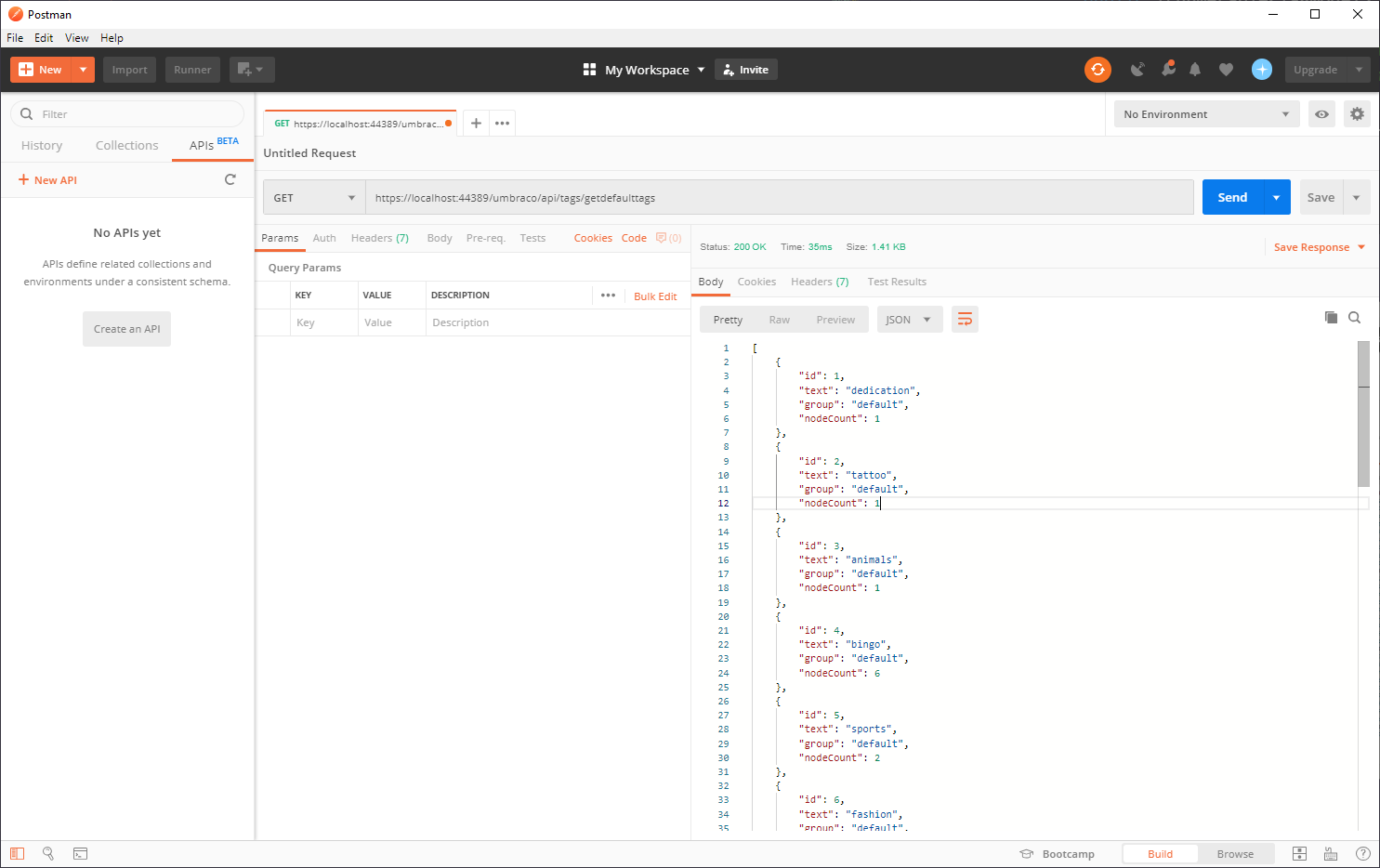Working with caching
This article will show you how to insert and delete from the runtime cache.
Scenario
For this example we're working with tags. On my site I have two tag properties:
One on every page using the tag group
defaultOne on my blog posts using the tag group
blog
We're going to expose an endpoint that allows us to get the tags from each group.
The tags from the default should be cached for a minute and the blog tags will be cached until site restart or if you publish a blog post node in the Backoffice.
Example
Why work with tags? Because they're not cached by default.. which makes them ideal for demo purposes :)
TagService
First we want to create our CacheTagService. In this example it's a basic class with one method (GetAll) that wraps Umbraco's TagQuery.GetAllTags().
using System;
using System.Collections.Generic;
using Umbraco.Core.Cache;
using Umbraco.Web;
using Umbraco.Web.Models;
namespace Doccers.Core.Services.Implement
{
public class CacheTagService : ICacheTagService
{
private readonly ITagQuery _tagQuery;
private readonly IAppPolicyCache _runtimeCache;
public CacheTagService(ITagQuery tagQuery, AppCaches appCaches)
{
_tagQuery = tagQuery;
// Grap RuntimeCache from appCaches
// and assign to our private field.
_runtimeCache = appCaches.RuntimeCache;
}
public IEnumerable<TagModel> GetAll(
string group,
string cacheKey,
TimeSpan? timeout = null)
{
// GetCacheItem will automatically insert the object
// into cache if it doesn't exist.
return _runtimeCache.GetCacheItem(cacheKey, () =>
{
return _tagQuery.GetAllTags(group);
}, timeout);
}
}
}
As you can see we inherit from the ICacheTagService interface. All that has is:
using System;
using System.Collections.Generic;
using Umbraco.Web.Models;
namespace Doccers.Core.Services
{
public interface ICacheTagService
{
IEnumerable<TagModel> GetAll(
string group,
string cacheKey,
TimeSpan? timeout = null);
}
}
The interface was created to better register it so we can use dependency injection. You can register your own classes like so:
using Doccers.Core.Services;
using Doccers.Core.Services.Implement;
using Umbraco.Core;
using Umbraco.Core.Composing;
namespace Doccers.Core
{
public class Composer : IUserComposer
{
public void Compose(Composition composition)
{
composition.Register<ICacheTagService, CacheTagService>();
}
}
}
Now you can inject ICacheTagService in any constructor in your project - wohooo!
API
Now that we have our service it's time to create an endpoint where we can fetch the (cached) tags.
using Doccers.Core.Services;
using System;
using System.Collections.Generic;
using System.Web.Http;
using Umbraco.Web.Models;
using Umbraco.Web.WebApi;
namespace Doccers.Core.Controllers.Api
{
public class TagsController : UmbracoApiController
{
private readonly ICacheTagService _tagService;
// Dependency injection rocks!
public TagsController(ICacheTagService tagService)
{
_tagService = tagService;
}
[HttpGet]
public IEnumerable<TagModel> GetDefaultTags()
{
// As mentioned earlier we want tags from "default"
// group to be cached for a minute.
return _tagService.GetAll("default", "defaultTags",
TimeSpan.FromMinutes(1));
}
[HttpGet]
public IEnumerable<TagModel> GetBlogTags()
{
// If you don't specify a TimeSpan the object(s)
// will be cached until manually removed or
// if the site restarts.
return _tagService.GetAll("blog", "blogTags");
}
}
}
/umbraco/api/tags/getblogtags:

/umbraco/api/tags/getdefaulttags:

Everything should now work as expected when it comes to getting tags. However, if I go to my Backoffice and add a new tag to the blog group the changes aren't shown on the endpoint. Let's fix that.
Clearing cache on publish
To clear the cache we need a component in which we register to the Published event on the ContentService. This allows us to run a piece of code whenever you publish a node.
using System.Linq;
using Umbraco.Core.Cache;
using Umbraco.Core.Composing;
using Umbraco.Core.Events;
using Umbraco.Core.Services;
using Umbraco.Core.Services.Implement;
namespace Doccers.Core
{
public class Component : IComponent
{
private readonly IAppPolicyCache _runtimeCache;
public Component(AppCaches appCaches)
{
// Again we can just grab RuntimeCache from AppCaches.
_runtimeCache = appCaches.RuntimeCache;
}
public void Initialize()
{
ContentService.Published += ContentService_Published;
}
private void ContentService_Published(IContentService sender,
ContentPublishedEventArgs e)
{
// We only want to clear the blogTags cache
// if we're publishing a blog post.
if (e.PublishedEntities
.Where(x => x.ContentType.Alias == "blogPost").Any())
{
_runtimeCache.ClearByKey("blogTags");
}
}
public void Terminate() {
//unsubscribe during shutdown
ContentService.Published -= ContentService_Published;
}
}
}
Now that we have our component we also need to register it. Add composition.Components().Append<Component>(); to the Compose method in the Composer class so it becomes:
public void Compose(Composition composition)
{
composition.Register<ICacheTagService, CacheTagService>();
composition.Components().Append<Component>();
}
Awesome! Now we have set up caching on our tags - making the site a bit faster. :)